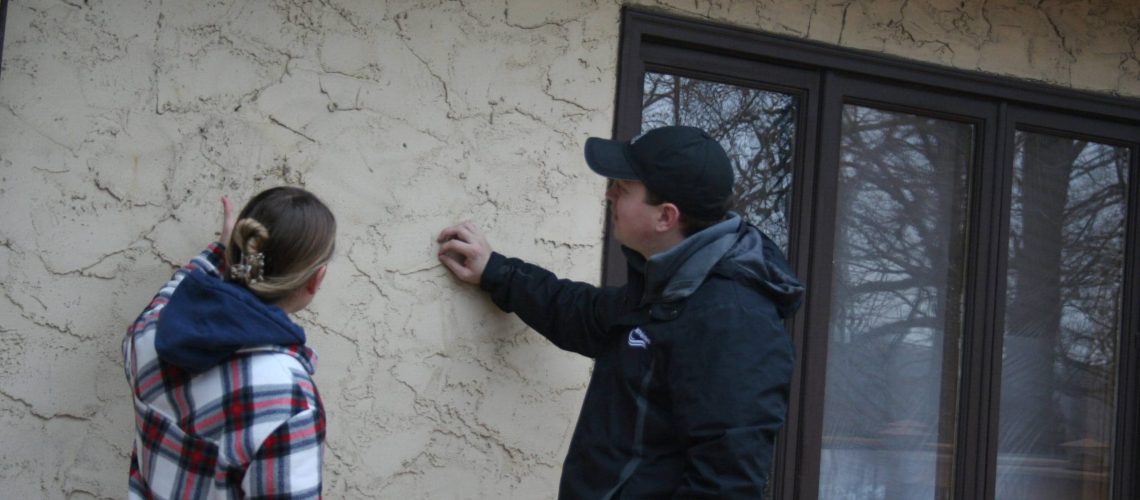After a fierce Minnesota storm, the exterior of your home may suffer significant damage, with one of the most noticeable signs being the condition of your exterior paint. Issues like peeling paint, flaking, and other paint-related problems not only diminish your house’s aesthetic appeal but also expose underlying surfaces to moisture. This can lead to more severe issues such as mildew and structural damage. Promptly identifying and repairing exterior paint damage is essential to maintaining the integrity and quality of your home’s exterior.
In this article, we will guide you through identifying common types of storm-related paint damage, the steps to repair it, and preventive measures to protect your home’s exterior paint job from future storms.
Identifying Common Types of Storm-Related Paint Damage
When inspecting your home’s exterior after a storm, it’s important to recognize the various types of paint damage that can occur. Here are some common issues you might encounter:
Chipping and Peeling
One of the most noticeable forms of storm-related paint damage is chipping and peeling. Strong winds, heavy rainfall, or hail can impact the painted surface, causing the paint film to detach from the underlying material. Peeling paint exposes wood or other surfaces to moisture, leading to problems like rot and mildew.
In Minnesota’s climate, with its significant temperature fluctuations, using high-quality exterior paint with excellent adhesion properties—such as those from JMJ Painters’ preferred suppliers like Sherwin-Williams—can help mitigate this issue.
Fading and Discoloration
Fading and discoloration can result from storm exposure, particularly due to intense sunlight and UV rays. While storms themselves may not directly cause fading, the subsequent sunlight after a storm can accelerate the process.
High-quality paints like Sherwin-Williams Duration are known for their superior color retention, helping maintain the vibrancy of your home’s exterior even under severe weather conditions.
Moisture Damage
Moisture damage is a significant concern after a storm, especially in areas prone to heavy rainfall or snowmelt. Water can seep behind the paint, causing it to peel or flake off. If not addressed, this can lead to more serious issues like mold, mildew, and structural damage.
Using semi-gloss or gloss finishes, which offer excellent moisture resistance, is ideal for areas frequently exposed to moisture, such as exterior doors, shutters, and trim.
Steps to Repair Paint Damage After a Storm
Repairing paint damage after a storm involves several critical steps to ensure a durable and high-quality finish. Here’s a step-by-step guide to help you through the process:
Cleaning and Preparing the Surface
Begin the repair process by thoroughly cleaning and preparing the surface. Remove any loose or peeling paint using a scraper, wire brush, or 80 to 100-grit sandpaper. This step is essential to ensure better adhesion of the new paint.
After scraping off the flaking paint, use a lightly water-dampened rag to remove any dust or debris from the area. This helps create a clean surface for the subsequent steps. Inspect the area for any cracks or holes and fill them with a patching material.
Allow the patching material to dry completely, then smooth out the area using 220-grit sandpaper. This ensures an even surface for painting. If necessary, apply additional layers of patching material and sand them down to achieve a seamless finish.
Addressing Moisture Issues
Moisture is a significant concern after a storm, as it can lead to further paint problems and structural issues. If there has been flooding or significant water exposure, it may take several months for the home to fully dry. Ensure that all surfaces are thoroughly cleaned and dried before proceeding with any repairs.
Painting over wet or damaged surfaces can exacerbate the problem, leading to more severe issues like mold and mildew. Check for signs of moisture damage, such as warping or rotting wood, and address these issues promptly.
Use a putty knife to fill any gaps or cracks, and apply a primer coat to help seal the surface and prevent future moisture intrusion.
Repainting Affected Areas
Once the surface is clean, dry, and repaired, it’s time to repaint the affected areas. Apply a high-quality primer coat to ensure excellent adhesion and coverage.
This is particularly important for exterior surfaces exposed to the elements. Use a premium exterior primer suitable for your specific paint type, whether it’s latex, oil-based, or acrylic latex.
After the primer has dried, apply the final coat of paint. Choose a high-quality exterior paint that is resistant to fading, chipping, and moisture.
Apply two coats if necessary, allowing the first coat to dry completely before applying the second. This ensures a durable and long-lasting paint job that can withstand future storms and weather conditions.
By following these steps, you can effectively repair paint damage after a storm and protect your home’s exterior from further deterioration.
Preventive Measures to Protect Your Home’s Exterior
To ensure your home’s exterior remains in excellent condition and withstands the harsh Minnesota climate, implementing preventive measures is essential. Here are some key strategies to consider:
Choosing the Right Paint and Materials
Selecting the right paint and materials is essential for protecting your home’s exterior. For Minnesota’s extreme climate, it is advisable to use high-quality exterior paints that offer superior durability and resistance to cracking and peeling. Paints like Sherwin-Williams Duration Exterior Acrylic Coating and Benjamin Moore Aura Exterior Paint are highly recommended for their advanced formulas that provide excellent fade protection, water-repelling features, and resistance to cracking and peeling.
Additionally, choosing the right paint sheen can make a significant difference. Semi-gloss or gloss finishes are ideal for areas exposed to snow, ice, and high humidity, such as window sills, door frames, and trim, as they create a protective barrier against moisture and make cleaning easier.
Regular Maintenance
Regular maintenance is vital to extend the life of your home’s exterior paint job. Schedule annual inspections to check for any signs of wear, such as peeling paint, mildew, or water damage. Address these issues promptly to prevent them from becoming more severe problems.
Ensure that gutters and downspouts are clear and functioning properly to prevent water from accumulating around the foundation of your home. Trim trees and shrubs to reduce the risk of branches scratching the paint. Also, power wash your home periodically to remove dirt and debris that can damage the paint over time.
Professional Assessments
While DIY maintenance is important, sometimes it’s beneficial to have a professional assessment. Hire a reputable painting contractor like JMJ Painters, who is familiar with Minnesota’s climate, to inspect your home’s exterior. They can identify potential issues before they become major problems and provide recommendations for the best paints and materials to use.
Professional painters can also advise on the optimal time to paint your home, typically between late spring and early fall in Minnesota, to ensure the paint adheres well and dries uniformly. This expertise can help maximize the longevity and appearance of your home’s exterior paint job.
Conclusion
Maintaining and enhancing the exterior of your home or business, especially after a storm, requires prompt and effective addressing of paint damage. Identify common types of storm-related paint damage such as chipping, peeling, and moisture issues. Follow the steps to repair these damages by cleaning and preparing the surface, addressing moisture problems, and repainting with high-quality materials. To prevent future issues, choose the right paint and materials, perform regular maintenance, and consider professional assessments.
For those in the Minnesota area, partnering with a trusted and reputable painting service like JMJ Painters ensures a stress-free and high-quality experience. With our commitment to integrity, craftsmanship, and community values, JMJ Painters delivers premium painting services that bring lasting beauty to your home or business. Schedule your free estimate today and experience the difference that certified professionals and a faith-driven commitment to excellence can make.
FAQ
What are the most common signs of storm damage to exterior paint that I should look for after a Minnesota storm?
After a Minnesota storm, look for chipped or peeling paint on your exterior walls, as these are common signs of storm damage, particularly from hail storms or heavy winds. Additionally, check for dripping, dark marks, and discoloration which can indicate moisture damage.
How can high winds, hail, and heavy rain affect the exterior paint of my home?
High winds can cause faded paint and moderate debris buildup, while also leading to black, red, and green stains. Hail can create physical damage such as dents and cracks in the paint.
Heavy rain can penetrate wood siding, causing it to absorb water, leading to chipping, peeling, and rot or mold growth.
What steps should I take to document and report storm damage to my exterior paint for insurance purposes?
To document and report storm damage to your exterior paint for insurance purposes, start by assessing the damage and determining its cause. Take detailed photos and videos of the affected areas from multiple angles. Keep records of all communication with your insurance company, including dates and summaries of conversations.
Collect estimates for repairs and receipts for any out-of-pocket expenses. Also, obtain any relevant weather reports or incident documentation to support your claim. Before removing any debris, document all losses thoroughly.
Why is it important to address storm damage to exterior paint promptly, and what are the potential consequences of delaying repairs?
Addressing storm damage to exterior paint promptly is essential to prevent further moisture penetration, which can lead to wood rot, mold, and mildew growth. Delaying repairs can result in structural damage, increased maintenance costs, and a compromised protective barrier against the elements, ultimately affecting the home’s integrity and visual appeal.

